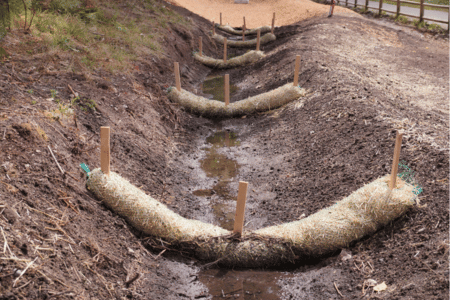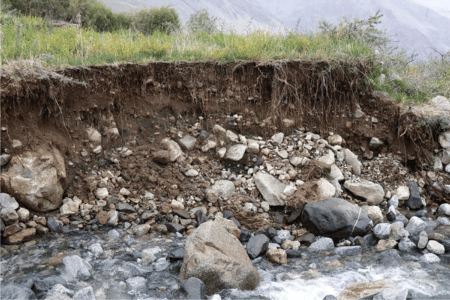Soil erosion is a significant issue that threatens our continued ability to grow food and contributes to water pollution worldwide. While natural vegetation can hold onto soil during periods of heavy rain and strong winds, construction zones tend to remove such vegetation, which increases the likelihood of sediment flowing away from the site.
Preventing and mitigating the problem through erosion and sediment control is essential for preserving the population’s health and environment. By working to avoid soil disturbance where possible and capturing sediment before it can escape, toxic substances such as pesticides, fertilizers, and construction debris won’t enter waterways, thus dramatically lessening the ecological impact of erosion or even stopping it entirely.
With the help of organizations and businesses such as Alpha-Omega Training and Compliance (AOTC), construction sites can avoid spreading harmful materials through erosion.
Table of Contents
What Is Erosion and Sediment Control?
When construction begins on a previously untouched landscape, several issues cause erosion to become an environmental problem, such as:
- The removal of natural vegetation
- The disturbance of topsoil
- The presence of toxic materials, such as oil and gas, or even exposure to natural (albeit harmful) contaminants like excessive nitrogen
Employing erosion and sediment control techniques prevents the soil from flowing into the environment and exposing people, plants, and animals to potentially hazardous materials.
Understanding Erosion Control vs. Sediment Control
Both erosion and sediment control are necessary for eliminating dangerous runoff and erosion, but they operate differently.
Erosion Control
As a preventive measure, erosion control stops soil and sediment from detaching and running off the site.
Sediment Control
As a reactive measure, sediment control captures already-flowing soil, sediment, and contaminants before they can escape a construction site.
Both control methods are essential to capturing pollutants and maintaining an environmentally safe site, as neither can contain all soil runoff or contaminants. In other words, these two strategies “stack,” complementing and working with one another.
The Science Behind Erosion and Sedimentation
Topsoil is the Earth’s outer layer and largely makes the planet capable of sustaining life. Plants require it to grow, and we rely on the food we cultivate from it to survive.
However, over the past 150 years, around half of the planet’s topsoil has eroded away. Rain is the natural force behind that erosion, but the continued vulnerability of bare topsoil, thanks to excavation and paving sites, compounds the issue. Exposed topsoil is loose and cannot hold itself together, so rainwaters pick it up and carry it to other locations.
After erosion, the next problem is sedimentation, in which that same soil settles into waterways such as streams and lakes, filling in gravelly and rocky areas, which clogs them up and causes the spread of pollutants. Insects, fish, and any other animals or plants that rely on the affected waterway will become exposed to the contaminants released by the soil, leading to illness and death.
By keeping rain from being able to transport contaminated soil, erosion and sedimentation don’t have a chance to occur — at least not in a way that can lead eroded soil to enter the environment.
Techniques Employed
A construction site can use many erosion and sediment control processes to avoid polluting the surrounding land.
Erosion Control Techniques
To prevent soil erosion, construction crews can use a combination of any of the following techniques:
1. Vegetation
Using the ability of natural vegetation to bind soil is a common erosion control method that can be employed in various ways. Some biowalls, for instance, use wire mesh coated in seeded compost to grow plants quickly and are then placed on the banks of rivers and creeks. There are also vegetated buffer strips, which are stretches of land that contain vegetation spread out in a way that captures rainwater.
2. Geotextiles
Whether synthetic or biodegradable, geotextiles come in mats, logs, and wattles that absorb and filter runoff to control erosion.
3. Retaining Walls
Instead of acting as a filter, retaining walls contain water and runoff so it can’t escape.
4. Mulch
On flat surfaces, mulch helps absorb water, preventing it from picking up loose soil and flowing away. Mulch can also be a sediment trap when ground finely and placed in filter socks.
Sediment Control Techniques
By its nature, sediment control methods are more about capturing runoff and contaminants once they’ve already left the construction site. Some strategies to consider include the following:
1. Silt Fences
These devices work to keep sediment from reaching nearby lakes and streams. They’re held in place with posts and are made of porous fabric, which captures escaped sediment and is easily replaceable as it gets bogged by high amounts of soil.
2. Sediment Traps
Construction crews can create a basin that captures runoff by excavating a small, strategically located section of earth. These are not suitable for drainage areas larger than five acres, however.
3. Storm Drain Inlet Protection
Inlet protection often takes the form of covers placed over storm drains to prevent runoff from entering sewer lines. These covers come in several varieties, including fabric, gravel, and sod, and they can also include filters that allow clean water to pass through. Care must be taken in any case since inlet protection can quickly become clogged with high amounts of flowing sediment.
Implementing Controls: A Step-by-Step Guide
Every construction site should adhere to best management practices to prevent erosion and sedimentation. Developing proper control plans requires careful planning and adhering to environmental regulations.
Designing Plans
Consider all possible ways in which pollutants and soil can escape your construction site and use the following steps to develop methods to prevent runoff from leaving the area.
1. Stabilize the Soil
Start your plans by looking for ways to keep the soil stable. Use vegetation, engineered soil, mulch, and even chemicals to prevent soil from being able to erode. Engineered soil designed to fight erosion is also an excellent option.
2. Diverting Runoff
Examine the area for likely paths of storm runoff. Using barriers and strategic excavation, guide the runoff to specific locations for filtration or holding.
3. Fix Areas Where Erosion Potential Is High
Steep slopes and open areas are prime runoff sites. Setting up impermeable walls and avoiding steep angles will allow water to flow slowly and predictably.
4. Keep Sediment and Other Contaminants On-Site
Find places that allow eroded soil to escape, such as entryways, gaps in walls, and areas where rain can ricochet beyond barriers, then consider the distance and height of your barriers, as they may need to be farther out than you think.
5. Develop Cleanup Plans
If contaminants do escape, you’ll need a plan for recovering and remediating the pollutants. Such a plan should be made in accordance with the severity of the materials, with highly toxic substances requiring much more care and urgency.
Maintaining and Monitoring Control Measures
Maintaining your erosion and sediment control measures requires vigilance. Filters will become clogged, and retaining walls can weaken and develop leaks. Routinely test your control measures to see if soil and contaminants pass through. Natural measures like vegetation need monitoring to ensure the plants thrive and continue binding soil together.
Before construction begins, crews will need to get permits from their local government, which may already have regulations regarding regular inspections and the allowed control measures. Construction crews who do not take these seriously and become lax can face serious fines and even jail time, depending on the severity of the contaminants released.
The Impact and Benefits of Control
With the proper erosion and sediment control methods in place, construction crews do than simply follow government regulations; they provide tangible benefits to the surrounding land, population, and local flora and fauna, such as:
1. Preventing Toxins from Entering the Environment
Toxic substances can find their way into fish, game animals, and otherwise edible plants. Such contaminants will harm not only the surrounding plants and wildlife but any humans who come into contact with them. It may also be that the toxins aren’t necessarily harmful to humans but cause plants and animals to become ill and susceptible to diseases that can then go on to harm humans.
2. Preventing Expensive Cleanup
Cleaning spills and runoff can be incredibly time-consuming and costly if it’s possible at all. Once pollutants enter the environment, they can spread far and fast. For extremely toxic substances, such as petroleum products or radioactive materials, cleanup will involve weeks, months, and even years of testing to ensure the contaminants have been eliminated.
3. Preserving Topsoil
As mentioned, topsoil is essential for sustaining human life, so the less we lose to erosion, the better. Growing the amount of food required to sustain life becomes virtually impossible without it.
4. Preserving Water Quality
Runoff can even enter drinking water, which opens the door to massive health risks, and even home filters cannot prevent all contaminants from leaking through. With that said, keeping these contaminants from potable water sources from the onset keeps populations healthy, leading to fewer missed workdays and better productivity, less of a strain on healthcare resources, and generally happier communities.
5. Preserving Land Value
Land that has experienced contamination is less valuable than clean land ready for use. Farmland, for that reason, is especially fragile and can be destroyed by erosion.
Success Stories
Erosion and sediment control aren’t theoretically valuable, but they’re practical methods that have proven real-world success.
1. Rwanda
The government of Rwanda put erosion and sediment control measures in place to preserve their farmlands, protecting 6,600 hectares of land. Their efforts reduced erosion, improved farming output, and relocated people from high-risk zones.
2. Gandak River
Monsoons routinely caused large runoff into the Gandak River until protection measures provided the banks with much-needed stability. Paramesh walls installed on the sloped sides and turf reinforcement mats stopped rainwater from eroding the soil.
3. New Hampshire
With increasing weather emergencies eroding the area’s farmland, the University of New Hampshire secured funding from the USDA Forest Service and the NH Division of Forest and Lands to implement erosion and sediment control techniques. With the help of compost filler socks and straw wattles, as well as timber mats and materials to slow the flow of water, they were able to slow erosion and protect area farmlands and forests.
Where to Find Services
Erosion is one of the largest environmental issues we face today, and without proper mitigation techniques, it can cause massive damage to the planet and human populations. Erosion and sediment controls are vital to ensure future sustainable growth and environmental preservation.
With the help of AOTC, you can ensure your construction projects don’t have ecologically damaging runoff entering local waterways. Contact AOTC and rely on our experience and expertise when implementing erosion and sediment controls. Explore our water resource engineering services today.




